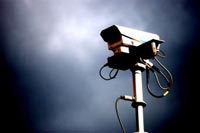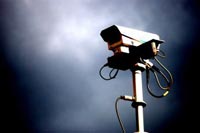
Catching Up
Technology ensures remote monitoring as a vital part of today's security needs
- By Bill Fitzhenry
- Feb 29, 2008
 From retail and manufacturing to healthcare and government, security departments and staff for decades have looked to security industry experts for new technology and services to improve operations and the bottom line. To that end, remote services provided by electronic security alarm providers that augment local security staff have become a frequent customer request. With advancements in IT and security technology, diverse remote security services are now possible, and a growing number of security industry leaders are introducing a vast assortment of such services.
From retail and manufacturing to healthcare and government, security departments and staff for decades have looked to security industry experts for new technology and services to improve operations and the bottom line. To that end, remote services provided by electronic security alarm providers that augment local security staff have become a frequent customer request. With advancements in IT and security technology, diverse remote security services are now possible, and a growing number of security industry leaders are introducing a vast assortment of such services.
Bridging the Gap
The most common remote services that customers request from innovative security providers are those using leading-edge video surveillance, access control systems and software. The most often-heard questions are: “Is there anything you can do to help me meet the local alarm verification requirements that does not require an expensive full-time guard service?” or “Can you help us manage adding or deleting access cards and changing door lock schedules so our administrative assistant or security guard can have time to do their real job?” The answer is a resounding yes.
With improved and more affordable bandwidth technology, expanded equipment functionality and specially trained central station staff, full-service alarm providers now can provide cost-effective remote alarm verification and access control management. Since most of these services are provided on an as-needed basis and the alarm company’s central station has the benefit of economies of scale and functionality expertise, the cost to customers for these remote services is typically significantly less than traditional guard services. Thus, with management’s goal to maximum effectiveness with minimum resources, today’s technical advancements can be leveraged without becoming overwhelming because of too many options.
Security companies continue to creatively use advancing technology to verify alarms, replace or augment security guards and ensure that employees adhere to standardized corporate procedures. Having an “extra set of eyes or ears” to substantiate events, check people gaining access to sensitive areas, provide security for employees opening and closing facilities, and help maintain stability at remote locations is now affordable.
Of all the remote monitoring options available today, alarm verification remains one of the most popular. With today’s high rate of false alarms, remotely viewing the scene to quickly verify an incident eliminates reliance on guard staff or customers to determine event specifics. By seeing what caused the alarm before dispatching authorities, businesses save time and money.
“The cost savings today due to proven technology advances is making remote monitoring a reasonable alternative,” said Felix Gonzales, vice president of strategic initiatives and business development at Stanley Convergent Security Solutions Inc. “We are able to enter into environments where we have not previously been. For example, with cameras and alarm systems already in place, and with a minimum investment by the customer or no additional investment with new installations, we are able to provide a wealth of video monitoring services for customers beyond basic video alarm verification.”
Visual Verification
By using video monitoring services, the identity of the person opening or closing a facility can be confirmed, while an employee’s presence at a predetermined place and time also can be verified. This allows customers to establish that the employee is doing what he is supposed to be doing—or not doing, for that matter—such as occupying a restricted area or removing items from the premise. Video also can reveal if a person is under duress—for example, being forced to gain access by a burglar.
“This is the quickest and most accurate method for determining what caused an alarm, providing a visual verification of the activity,” said Steve Walker, vice president of the ProtectionNet customer service center at Stanley Convergent Security. “Because the alarm panel only sends a signal, it doesn’t allow you to view the local premise to get more information.”
On the other hand, by integrating remotely controlled PTZ cameras, video monitoring and two-way audio access points, more information is immediately and accurately available.
“HSM - Stanley has enhanced its alarm verification services to include two-way audio video service,” Walker said. “For example, if an incident occurs and we can see a guard or janitor on the scene, we are able to have an immediate two-way conversation with them to understand what happened and what details they can provide. We’ve not only documented the event, but we have had the opportunity to have a real-time conversation with someone on-site with information about the event.
“Video monitoring is the ultimate in remote monitoring services by serving to replace or augment the customer’s local security staffs. With the traditional central station going by the wayside as a passive function—waiting for a signal to be activated, then taking action—remote monitoring offers a higher level of security, documentation and an economical approach.”
Among the current uses of remote video surveillance are virtual guard tours, meaning a central station operator tours an entire facility through its video surveillance system. Instead of relying on full-time guard staff, monitoring specialists can conduct remote guard tours, accessing what local guards see at the incident. The major advantage here is recording everything that is viewed, archiving it and being able to retrieve the online, real-time information as needed.
“This allows for absolute accuracy of the video and time stamp versus the memory of a person,” Gonzales said. “From a documentation standpoint, real-time video can be used for investigations, as well as for prosecution at a much higher rate of success over that of an eyewitness.”
“Many of our customers are Fortune 500 and multilocation businesses,” said Chris BenVau, vice president of national accounts at Stanley. “Managing a number of remote locations across a region, a state or the United States is a significant challenge these companies face every day. From employee work schedules, vendor deliveries, corporate policy compliance, internal and external security to the overall operation of the business, these companies are searching for service providers who have the technology and expertise to partner with them by providing remote services that allow them to focus their local resources on their business and customers.”
Do More
Video alarm verification and remote managed access control are only the beginning of the services that alarm companies will provide. In the future, more alarm companies will provide services that include video audits that ensure compliance to company policy procedures at every remote location for a company. Scorecards would be provided to make certain every location is complying with company marketing, operations and customer policy requirements.
As long as technology continues to make steady and reliable advancements and alarm companies continue to understand customer needs, remote service will evolve and expand. Thus, security providers are offering customers the ability to do more with the help of people who are miles away but still connected intimately with their facility and business.